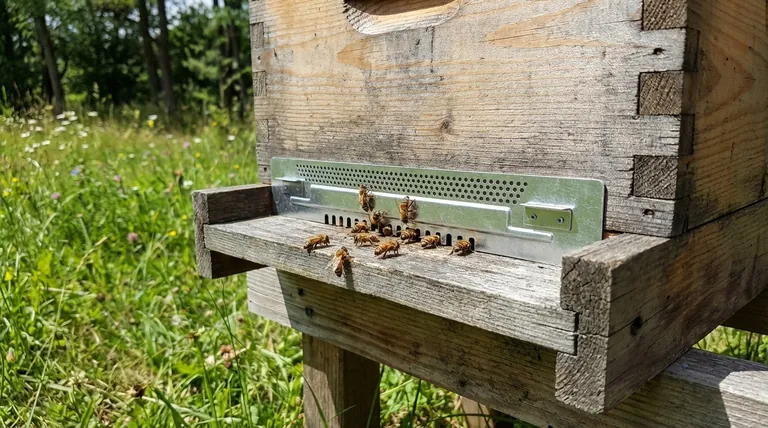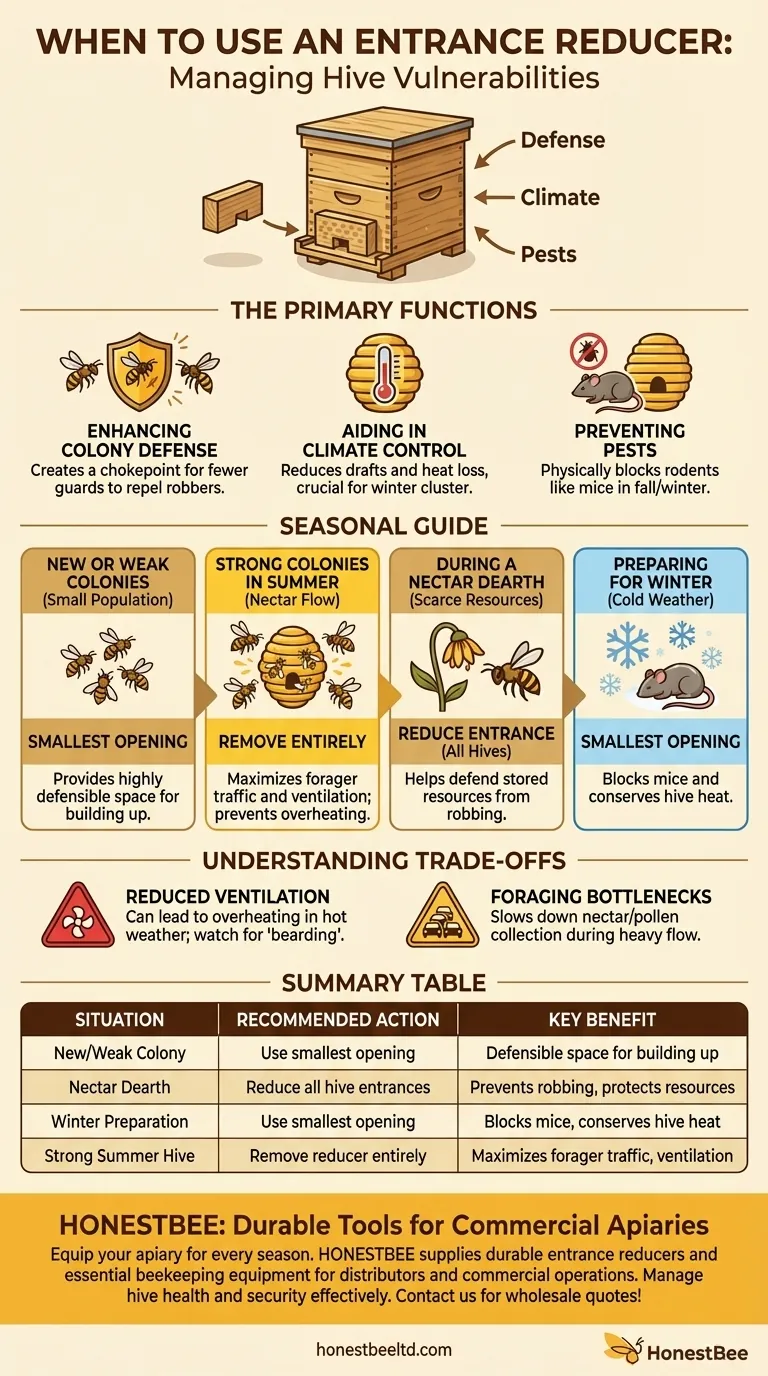At its core, an entrance reducer is a tool for managing a honey bee colony's vulnerabilities. You should use one whenever a colony is small, newly established, or weak, and especially during winter or nectar dearths when the risk of robbing from other insects is high. It helps the bees defend their home, control their climate, and keep out pests.
An open hive entrance is both a gateway and a liability. The strategic use of an entrance reducer is about balancing the colony's need for defense and climate control against its need for ventilation and forager traffic, a balance that shifts with the seasons and the colony's strength.

The Primary Functions of an Entrance Reducer
A simple block of wood or plastic, an entrance reducer serves three critical functions that directly impact a colony's health and survival.
Enhancing Colony Defense
A wide-open entrance is difficult for a small population of guard bees to defend.
By constricting the entrance, you create a chokepoint. This allows a smaller number of guards to effectively repel robbers like wasps, hornets, and bees from other hives.
Aiding in Climate Control
Bees work tirelessly to maintain a stable temperature and humidity inside their hive, especially in the brood nest where larvae are developing.
A smaller opening reduces drafts and minimizes heat loss. This is particularly crucial during the winter, as it helps the cluster conserve energy and stay warm.
Preventing Pests
During the fall and winter, small rodents like mice often seek warm, sheltered places to nest. A beehive full of honey and pollen is an ideal target.
Using the smallest setting on your entrance reducer is often enough to physically block mice from entering and destroying the hive over winter.
A Seasonal Guide to Using Your Reducer
The decision to use a reducer—and which opening size to use—is not static. It should be adapted to the time of year and the specific condition of the hive.
For New or Weak Colonies
When you install a new package or nucleus hive, its population is small. It has minimal resources and few guard bees.
Always start these colonies with the smallest entrance opening. This gives them a highly defensible space, allowing them to focus on building comb and raising brood without expending excess energy on defense.
For Strong Colonies in Summer
A thriving, populous hive during a strong summer nectar flow is a different scenario entirely. Thousands of foragers are coming and going constantly.
In this case, the entrance should be fully open. A reducer would create a traffic jam, hindering foraging and reducing ventilation, which can lead to the hive overheating.
During a Nectar Dearth
A nectar dearth is a period, often in late summer, when flowers stop producing nectar. This makes resources scarce and can trigger intense robbing behavior between hives.
During a dearth, you should reduce the entrance on all your hives, even the strong ones. This helps every colony defend the resources it has stored.
Preparing for Winter
As temperatures drop in the fall, the colony's population begins to shrink in preparation for winter.
This is the most critical time to use a reducer. Set it to the smallest opening to protect against mice and provide maximum assistance in retaining heat throughout the cold months.
Understanding the Trade-offs
Using an entrance reducer is not without potential downsides. Understanding these limitations is key to using the tool effectively.
Reduced Ventilation
The primary trade-off is a decrease in airflow. In hot and humid weather, a restricted entrance can contribute to the hive overheating.
You may see bees "bearding"—clustering on the outside of the hive—as they try to cool down. This is a clear sign that they need more ventilation.
Foraging Bottlenecks
During a heavy nectar flow, a small opening can create a traffic jam for foragers. This can slow down the collection of nectar and pollen, potentially reducing the amount of honey the hive produces.
This is why it's crucial to remove the reducer once a colony is strong enough and nectar is abundant.
Making the Right Choice for Your Colony
There is no single "set it and forget it" rule. Adjusting the entrance is a key part of active hive management.
- If you are installing a new package or nuc: Start with the smallest opening to give them a defensible space while they build up.
- If you have a strong, populous hive in a nectar flow: Remove the reducer entirely to maximize airflow and forager traffic.
- If you notice robbing or are in a nectar dearth: Immediately reduce the entrance to the smallest defensible size for all hives.
- If you are preparing for winter: Use the smallest opening to protect against mice and conserve precious heat.
Ultimately, observing your colony's strength and the current environmental conditions is the key to managing your hive entrance effectively.
Summary Table:
| Situation | Recommended Action | Key Benefit |
|---|---|---|
| New/Weak Colony | Use smallest opening | Provides a defensible space for building up |
| Nectar Dearth | Reduce all hive entrances | Prevents robbing and protects resources |
| Winter Preparation | Use smallest opening | Blocks mice and conserves hive heat |
| Strong Summer Hive | Remove reducer entirely | Maximizes forager traffic and ventilation |
Equip your apiary with the right tools for every season. HONESTBEE supplies durable entrance reducers and essential beekeeping equipment to commercial apiaries and distributors. Let our wholesale-focused operations help you manage hive health and security more effectively. Contact our team today to discuss your needs and request a quote!
Visual Guide

Related Products
- Beehive Entrance Reducer Guardian Metal Hive Entrance for Bees
- Multi-Functional Sliding Hive Entrance for Beekeeping
- Multi-Functional Rotary Hive Entrance Disc for Beekeeping
- HONESTBEE Professional Long Handled Hive Tool with Precision Cutting Blade
- Professional Hive Front Entrance Bee Feeder
People Also Ask
- What happens if you seal an entrance to a bee hive? Avoid a Costly Structural Disaster
- How big should a beehive entrance be? Optimize for Colony Health & Honey Production
- What size is the entrance hole in a native bee hive? The 13mm Standard for a Thriving Colony
- What are the features of the side with oblong holes in the entrance reducer? A Guide to Hive Defense & Health
- What are the different types of entrance reducers available? A Guide to Protecting Your Hive



















